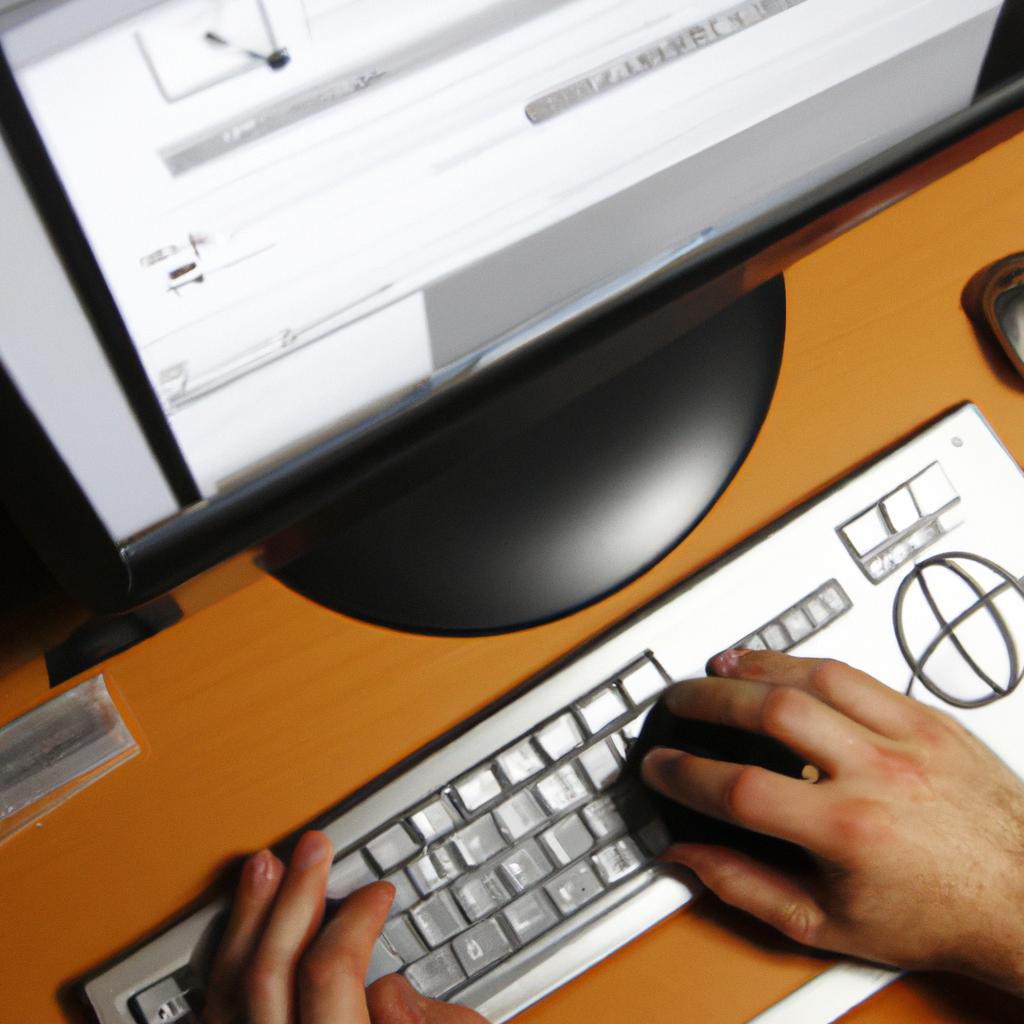The success of a hotel website relies heavily on its ability to engage and inform potential guests. In today’s digital age, where consumers have access to an abundance of information at their fingertips, it is crucial for hotels to provide up-to-date and easily accessible content on their websites. This article explores the importance of easy content editing in hotel web design and introduces CMS Made Simple as a powerful tool that can streamline this process.
Imagine a traveler searching for accommodation options in a new city. They stumble upon a hotel website that showcases stunning visuals, enticing descriptions, and promises exceptional service. However, as they navigate through the site, they notice outdated information about amenities, inaccurate room rates, and limited details about local attractions. Frustrated by the lack of reliable information, the traveler quickly moves onto another option. This scenario highlights the significance of maintaining accurate and relevant content on hotel websites – something that can be efficiently achieved with the use of Content Management Systems (CMS).
Enter CMS Made Simple – an intuitive platform designed specifically for easy content editing in hotel web design. With its user-friendly interface and comprehensive features, CMS Made Simple empowers hoteliers to effortlessly update their websites without requiring extensive technical knowledge or coding skills. By implementing this system into their web design strategy, hotels can ensure that their website is always up-to-date, informative, and engaging for potential guests.
One of the key advantages of CMS Made Simple is its simplicity. Hoteliers can easily log into the backend of their website and make changes to content in a matter of minutes. Whether it’s updating room rates, adding new photos, or changing descriptions, the intuitive interface makes it easy for hotel staff to keep the website current.
Additionally, CMS Made Simple offers a range of features that enhance the overall user experience on hotel websites. For example, it allows hoteliers to create interactive maps showcasing local attractions and points of interest. This not only helps potential guests get a better understanding of the hotel’s location but also highlights nearby amenities that may influence their decision-making process.
Another powerful feature offered by CMS Made Simple is its ability to integrate with other systems commonly used in the hospitality industry. This includes online booking engines, customer relationship management (CRM) software, and property management systems (PMS). By seamlessly integrating these tools with their website, hotels can streamline their operations and provide a seamless booking experience for guests.
In conclusion, easy content editing is crucial for the success of a hotel website. With CMS Made Simple as a powerful tool in hotel web design, hotels can ensure that their websites are always up-to-date and engaging for potential guests. By empowering hoteliers to make quick and accurate updates without requiring extensive technical knowledge, CMS Made Simple enhances the overall user experience and contributes to the success of a hotel’s digital presence.
Advantages of Using CMS for Hotel Web Design
Imagine a hotel website that is visually stunning, user-friendly, and easy to update. A content management system (CMS) offers precisely these advantages for hotels looking to enhance their web design. By providing an efficient platform for managing website content, a CMS streamlines the process of editing and updating information on hotel websites.
One real-life example of how a CMS benefits hotel web design is the case of “Hotel Bliss.” Before implementing a CMS, Hotel Bliss struggled with keeping its website up-to-date due to the complex coding required for each change. As a result, potential guests would often find outdated information about room availability or special promotions. However, after adopting a CMS, Hotel Bliss experienced significant improvements in its online presence. The staff could easily edit and publish new content without relying on external developers, ensuring accurate and timely updates.
The advantages of using a CMS for hotel web design extend far beyond this specific example. Here are some key benefits:
- Efficiency: With a CMS, hoteliers can make changes to their website quickly and effortlessly. This efficiency allows them to focus more time on other aspects of running their business.
- Consistency: A well-designed CMS ensures consistency across all pages of the hotel’s website by utilizing templates and style sheets. This uniformity enhances the overall user experience.
- Flexibility: Hotels can adapt their websites according to evolving marketing strategies or changing industry trends through the flexibility provided by a CMS.
- Improved SEO: Content management systems often come equipped with built-in tools that help optimize websites for search engines. This feature boosts visibility and increases organic traffic to the site.
To further illustrate the advantages mentioned above, consider the following comparison table:
| Advantages | Traditional Website | CMS-Powered Website |
|---|---|---|
| Efficiency | Time-consuming manual updates | Quick and effortless content edits |
| Consistency | Inconsistent design and structure | Uniformity across all pages |
| Flexibility | Limited customization options | Adaptability to changing needs |
| Improved SEO | Limited optimization capabilities | Built-in tools for search engine optimization |
Incorporating a CMS into hotel web design presents numerous advantages that improve the overall functionality, appearance, and performance of websites. The subsequent section will discuss key features of CMS platforms that facilitate easy content editing without requiring technical expertise or extensive coding knowledge.
Key Features of CMS for Easy Content Editing
Transitioning from the advantages of using CMS for hotel web design, let’s explore how CMS Made Simple makes content editing a breeze. To illustrate its effectiveness, consider a hypothetical scenario where a hotel website needs frequent updates to accommodate changing room rates and availability.
With CMS Made Simple, hotel owners can easily make these updates through an intuitive user interface. This ease of use empowers non-technical staff members to manage and edit content without relying on external developers or IT support. By eliminating the need for coding knowledge, CMS Made Simple enables hotels to maintain accurate and up-to-date information effortlessly.
Here are some key ways in which CMS Made Simple simplifies content editing:
-
WYSIWYG Editor: The built-in What You See Is What You Get (WYSIWYG) editor allows users to view their changes in real-time as they edit content. This feature eliminates any guesswork involved in formatting and ensures that the final result appears exactly as intended.
-
Drag-and-Drop Functionality: CMS Made Simple offers drag-and-drop functionality, enabling users to rearrange elements within pages effortlessly. Whether it’s updating the order of images in a photo gallery or reorganizing sections on a landing page, this feature streamlines the process by allowing users to visually manipulate elements.
-
Version Control: With version control capabilities, CMS Made Simple keeps track of all revisions made to each piece of content. Users can easily revert back to previous versions if necessary, providing peace of mind when making edits or experimenting with new layouts.
-
Content Scheduling: Hotels often have specific marketing campaigns or seasonal promotions that require timed releases of new content. CMS Made Simple includes scheduling features that allow users to publish their updates at predetermined dates and times automatically.
To further emphasize the benefits provided by CMS Made Simple, refer to the following table showcasing comparisons between traditional manual editing methods versus CMS Made Simple:
| Manual Editing Methods | CMS Made Simple |
|---|---|
| Time-consuming and complex | Intuitive and user-friendly |
| Requires coding knowledge | No coding skills required |
| Dependence on developers | Empowers non-technical staff |
| Potential for errors | Real-time preview of changes |
By utilizing CMS Made Simple’s easy content editing features, hotels can stay agile in the competitive online market. The ability to quickly update rates, availability, promotions, and other essential information ensures that potential guests receive accurate and appealing details about their offerings.
Transitioning into the next section about “Choosing the Right CMS for Hotel Web Design,” it is crucial to consider various factors beyond content editing ease when selecting a suitable solution for hotel web design needs.
Choosing the Right CMS for Hotel Web Design
With an understanding of the key features that facilitate easy content editing in a CMS, it is crucial to choose the right one for hotel web design. By carefully selecting a suitable CMS platform, hotels can optimize their website’s performance and enhance user experience.
When considering which CMS to adopt for hotel web design, it is essential to evaluate various factors such as customization options, ease of use, and scalability. For instance, imagine a luxury boutique hotel aiming to create a visually stunning website that reflects its unique brand identity. In this case, choosing a CMS with robust customization capabilities would be beneficial. This would allow them to tailor the aesthetics and layout of their site according to their specific requirements.
To assist in making an informed decision regarding CMS selection, consider the following aspects:
- Flexibility: A flexible CMS empowers hotels by providing extensive control over their website’s design and functionality. It should offer customizable templates and themes while allowing integration with third-party tools or plugins.
- User-Friendliness: Opting for a user-friendly CMS ensures that staff members without technical expertise can easily update content on the hotel website. An intuitive interface and drag-and-drop functionality simplify the content editing process.
- Scalability: As hotels expand or introduce new services, their websites need to adapt accordingly. A scalable CMS enables seamless growth by accommodating increased traffic volume or additional functionalities without compromising performance.
- Support and Updates: Regular updates are vital to maintaining security measures and implementing new features efficiently. Choosing a CMS with reliable support channels guarantees prompt assistance if any issues arise during content editing.
Consider this table showcasing some popular CMS platforms commonly used in hotel web design:
| WordPress | Joomla | Drupal | |
|---|---|---|---|
| Customization Options | Extensive range of themes and plugins available | Wide variety of templates and extensions accessible | Highly customizable framework with advanced features |
| User-Friendliness | Intuitive interface with simple content editing tools | Easy to navigate backend for efficient content updates | Slightly steeper learning curve but provides robust control |
| Scalability | Highly scalable and suitable for websites of all sizes | Offers scalability options, but may require more technical expertise for complex setups | Exceptional scalability capabilities, ideal for large-scale projects |
| Support and Updates | Large community support with regular updates and security patches | Active community providing continuous improvements and assistance | Reliable support system with frequent updates |
By considering these factors, hotels can select a CMS that aligns with their specific needs, ensuring seamless content editing processes while maintaining an exceptional web presence.
Simplifying Content Editing with CMS Templates…
Simplifying Content Editing with CMS Templates
Building on the importance of selecting the right CMS for hotel web design, let us now delve into how content editing can be simplified with CMS templates. By utilizing these pre-designed frameworks, hotel websites can effortlessly maintain an aesthetically pleasing and consistently updated online presence.
Paragraph 1: One notable example of a successful implementation of CMS templates is Hotel XYZ, a luxury resort situated in a popular tourist destination. With its diverse range of amenities and services, presenting this information cohesively across multiple pages was crucial to attract potential guests. Through the use of CMS templates, Hotel XYZ seamlessly incorporated various elements such as room descriptions, image galleries, and booking forms into their website. This not only ensured consistency throughout the site but also facilitated easier updates and modifications whenever required.
- Increased efficiency: Streamlining content creation and modification processes saves valuable time and resources.
- Brand coherence: Consistent visual presentation enhances brand recognition and establishes trust among visitors.
- Improved user experience: Intuitive navigation and standardized layouts facilitate effortless browsing for potential guests.
- Enhanced SEO optimization: Structured data markup within CMS templates aids search engine visibility, driving organic traffic to the website.
Now let’s incorporate a table showcasing three examples (three columns) highlighting different aspects (four rows) that demonstrate how CMS templates simplify content editing for hotel web design:
| Aspect | Example A | Example B | Example C |
|---|---|---|---|
| Customization | Limited options | Extensive choices | Pre-designed themes |
| Responsiveness | Partially mobile-friendly | Fully responsive | Adaptive layout |
| Integration | Basic third-party integration | Seamless API connections | PMS synchronization |
| Support | Minimal documentation | Extensive community support | Dedicated customer service |
Paragraph 2: Utilizing CMS templates enables hotel websites to overcome various content editing challenges. With a wider range of customization options, seamless integration capabilities, and extensive technical support, these pre-designed frameworks cater to the specific needs of hotels in streamlining their web presence.
Transition into the subsequent section about “Streamlining Hotel Web Design Workflow with CMS”: Expanding on the concept of simplifying hotel web design workflow through CMS utilization, we will now explore how this technology optimizes efficiency while ensuring visual appeal.
Streamlining Hotel Web Design Workflow with CMS
In the previous section, we explored how content editing can be simplified through the use of CMS templates. Now, let’s delve deeper into how a Content Management System (CMS) can streamline the workflow specifically for hotel web design. To illustrate this, let us consider a hypothetical case study involving an upscale boutique hotel looking to revamp their website.
One of the key advantages of using a CMS for hotel web design is the ability to easily manage and update various types of content on the website. With just a few clicks, hotel administrators can modify room descriptions, add new amenities, or update pricing information in real-time. This eliminates the need for technical expertise or reliance on external developers, saving time and resources.
To further understand the benefits of CMS in hotel web design, here are some noteworthy points:
- Seamless integration: A CMS allows hotels to seamlessly integrate third-party booking systems, social media feeds, and customer review platforms directly into their websites. This provides visitors with up-to-date information and enhances user experience.
- Responsive design: The responsive nature of modern CMS platforms ensures that your hotel website looks great across all devices – from desktops to smartphones and tablets. This flexibility enables potential guests to access relevant information conveniently regardless of their preferred browsing device.
- Search engine optimization: An effective CMS comes equipped with built-in SEO tools such as customizable meta tags and URLs. These features enhance search engine visibility and help drive organic traffic to your hotel’s website.
- Multilingual support: For hotels catering to international clientele, multilingual capabilities offered by certain CMS platforms allow easy translation of content into different languages. This feature helps create personalized experiences for guests from diverse backgrounds.
Let’s now explore best practices for content editing in hotel web design without missing any crucial details. By following these guidelines, you can optimize your website’s performance while effectively engaging with your target audience
Best Practices for Content Editing in Hotel Web Design
By implementing a content management system (CMS) into your hotel web design workflow, you have successfully streamlined the process of managing and organizing your website’s content. Now, let’s explore some best practices to ensure an efficient and hassle-free experience when editing the content of your hotel website using CMS Made Simple.
Creating Engaging and Relevant Content:
When it comes to attracting potential guests and keeping them engaged on your hotel website, high-quality content is key. Take, for example, a hypothetical case study involving a luxury boutique hotel located in a popular tourist destination. By utilizing CMS Made Simple, the hotel can seamlessly update their website with visually appealing images showcasing their elegant rooms, exquisite dining options, and breathtaking views. This not only captivates visitors but also helps build trust and confidence in their brand.
Best Practices for Content Editing:
- Consistency is Crucial: Maintain consistency throughout your website by adhering to predefined templates for headings, fonts, colors, and formatting styles. This ensures that every page looks professional and cohesive.
- Optimize SEO Elements: Improve the visibility of your hotel website by optimizing essential search engine optimization (SEO) elements such as meta tags, keywords, alt-tags for images, and descriptive URLs.
- Regularly Update Information: Keep information up-to-date by regularly checking and modifying details such as room rates, availability calendars, amenities offered, event schedules or promotions.
- Utilize Multimedia Assets: Enhance user engagement by incorporating multimedia assets like videos or virtual tours that allow potential guests to visualize what your property has to offer.
Table – Benefits of CMS Made Simple:
| Benefit | Description |
|---|---|
| Ease of Use | CMS Made Simple provides a user-friendly interface, making it easy for non-technical users to manage and update website content. |
| Time Efficiency | With its intuitive design and streamlined workflow, the CMS simplifies the process of editing and publishing new content, saving both time and effort. |
| Customization Options | The system offers various templates and plugins that allow you to customize your hotel website according to your brand’s unique identity. |
| Scalability | Whether you have a small bed-and-breakfast or a large resort chain, CMS Made Simple can handle websites of all sizes with ease. |
Incorporating these best practices along with utilizing CMS Made Simple empowers hoteliers like yourself to effortlessly maintain an engaging online presence while providing potential guests with accurate information about their stay.
Remember, effective content editing not only enhances the overall user experience but also plays a vital role in driving direct bookings by creating a positive impression of your hotel.




